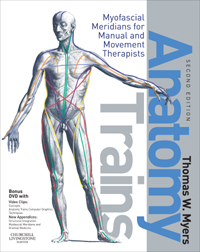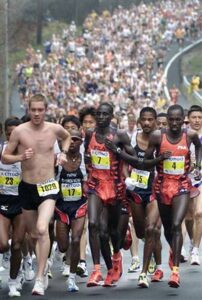The Fascial Knock on Distance Running for Pitchers
A while back, I had the privilege to experience Thomas Myers in seminar for the first time. For those who aren’t familiar with Myers, he is the author of Anatomy Trains and a pioneer in the world of bodywork and fascial research.
There were a wide variety of attendees present, and Myers made dozens of interesting points – so the take-away message could easily have been different for everyone in attendance as they attempted to fit his perspective into their existing schemeta.
While I enjoyed all 150 minutes of his presentations, the portion of Myers’ talk that jumped out at me the most was his list of the eight means of improving “fascial fitness:”
1. Use whole body movements
2. Use long chain movements
3. Use movements including a dynamic pre-stretch with proximal initiation
4. Incorporate vector variation
5. Use movements that incorporate elastic rebound – this consists of cylic motions of a certain speed (for instance, cycling wouldn’t count)
6. Create a rich proprioceptive environment
7. Incorporate pauses/rest to optimize hydration status
8. Be persistent, but gentle (prominent changes can take 18-24 months)
A big overriding them of Myers’ lecture was that the role of the fascia – the entire extracellular matrix of the body – is remarkably overlooked when it comes to both posture and the development of pathology. He remarked that he doesn’t feel like we have 600+ muscles in the body; he feels like we have one muscle in 600+ fascial pockets because they are so interdependent. And, in this fascia, we have nine times as many sensory receptors as we’ve got in muscles.
Think about what that means when someone has rotator cuff problems – and treatment only consists of ice, stim, NSAIDs, and some foo-foo rotator cuff exercises. Or, worse yet, they just have a surgical intervention. It overlooks a big piece of the puzzle – or, I should say, the entire puzzle.
For me, though, these eight factors got me to thinking again about just how atrocious distance running is for pitchers. I have already ripped on it in the past with my article A New Model for Training Between Starts, but this presentation really turned on a light bulb over my head to rekindle the fire. Let’s examine these eight factors one-by-one:
1. Use whole body movements – Distance running may involve require contribution from the entire body, but there is not a single joint in the body that goes through an appreciable range of motion.
2. Use long chain movements – Pitching is a long chain movement. Jumping is a long chain movement. The only things that are “long” about distance running are the race distances and the length of the hip replacement rehabilitation process.
3. Use movements including a dynamic pre-stretch with proximal initiation – This simply means that the muscles of the trunk and hips predominate in initiating the movement. While the hips are certainly important in running, the fundamental issue is that there isn’t a dynamic pre-stretch. This would be a dynamic pre-stretch with proximal initiation:
4. Incorporate vector variation – A vector is anything that has both force and direction. Manual therapists vary the force they apply to tissues and the directions in which they apply them. There are obviously vectors present in exercise as well. Here are 30,000 or so people, and pretty much just one vector for hours: forward (to really simplify things):
Incorporating vector variation into programs is easy; it just takes more time and effort than just telling someone to “run poles.” Take 8-10 exercises from our Assess and Correct DVD set and you’ve got a perfect circuit ready to roll.
5. Use movements that incorporate elastic rebound – Sorry, folks, but even though the stretch-shortening cycle is involved with jogging, its contribution diminishes markedly as duration of exercise increases. And, frankly, I have a hard time justifying bored pitchers running laps as “elasticity.”
6. Create a rich proprioceptive environment – There is nothing proprioceptively rich about doing the same thing over and over again. They call it pattern overload for a reason. Pitchers get enough of that!
7. Incorporate pauses/rest to optimize hydration status – Myers didn’t seem to have specific recommendations to make regarding work: rest ratios that are optimal for improving fascial fitness, but I have to think that something more “sporadic” in nature – whether we are talking sprinting, agility work, weight training, or dynamic flexibility circuits – would be more appropriate than a continuous modality like jogging. This is true not just because of duration, but because of the increased vector variation potential I outlined earlier.
8. Be persistent, but gentle – This one really hit home for me. Significant fascial changes take 18-24 months to really set in. I am convinced that the overwhelming majority of injuries I see in mature pitchers are largely the result of mismanagement – whether it’s overuse, poor physical conditioning, or improper mechanics – at the youth levels. Poor management takes time to reach the threshold needed to cause symptoms. In other words, coaches who mismanage their players over the course of the few months or years they coach them may never actually appreciate the physical changes – positively or negatively – that are being set into action.

Distance running might seem fine in the short-term. Overweight kids might drop some body fat, and it might make the practice plan easier to just have ’em run. Kids might not lose velocity, as they can compensate and throw harder with the upper extremity as their lower bodies get less and less powerful and flexible.
However, it’s my firm belief that having pitchers run distances not only impedes long-term development, but also directly increases injury risk. Folks just don’t see it because they aren’t looking far enough ahead.
Please enter your email below to sign up for our FREE newsletter and you’ll receive a deadlift technique video!




